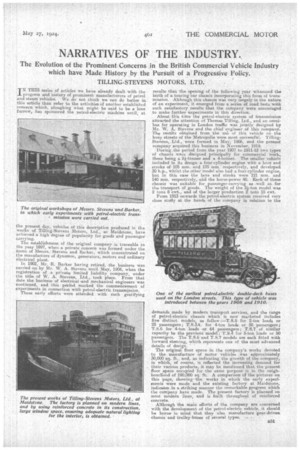NARRATIVES OF THE INDUSTRY.
Page 17

If you've noticed an error in this article please click here to report it so we can fix it.
The Evolution of the Prominent Concerns in the British Commercial Vehicle Industry which have Made History by the Pursuit of a Progressive Policy.
TILLING-STEVENS MOTORS, LTD.
IN THIS series of articles we have already dealt with the I_ progress and history of prominent manufacturers of petrol and steam vehicles. Wo -do not think we can do better in this article than refer to the activities of another established concern which, ploughing what might be said to be a lone furrow, has sponsored the petrol-electric Machine until, at
the present day, vehicles of this description produced in the works of Tilling-Stevens Motors, Ltd, at Maidstone, have achieved a high degree of popularity for goods And passenger carrying. The establishment of the original company is traceable to the year 1897, when a private concern was formed under the name of Messrs. Stevens and 15,arker, which concentrated on the manufacture of dynamos, generators, motors and ordinary electrical plant. In 1902, Mr. B. Harker having retired, the business was carried-on by Mr. W. A. Stevens until May, 1906, when the registration of a private limited liability company, under the title of W. A. Stevens, Ltd., took place. From that date the business of electrical and mechanical engineers was continued, and this period marked the commencement of experiments in connection with petrol-electric transmission. These early efforts were attended with such gratifying results that the opening of tbe following year witnessed the birth of a touring car chassis incorporating this form of transmission, Although this chassis was very Jargeiy in the nature of an experiment, it emerged from a series of road tests with such satisfactory results that the company were encouraged to make further experiments in this direction. .
About this time the petrol-electric system of transmission attracted the attention of Thomas Tilling, Ltd., arid an omnibus for operating in London traffic was jointly designed by Mr. W. A. Stevens and the chief 'engineer of this company. The results obtained from the use of this vehicle on the busy streets of the Metropolis were most successful. TillingStevens, Ltd., were formed in May, 1906, and the present company acquired this business in November, 1919.
During the period from the year 1907 to 1911-12 two types of chassis were designed principally for commercial work, these being a, 2i-toriner and a 4-tonner. The smaller vehicle included in its design a four-cylinder engine with a bore and stroke of •105 mm. and 125 .mm.' respectively, and developed 50 h.p., whilst the other model also had a four-cylinder engine, but in this case the bore and stroke were 121 mm. and 140 mm. respectively, and the horse-power 40. Each of these chassis was suitable for passenger-carrying as -well as for the transport of goods. The weight of the 2i-ton model was 2 tons 8 cwt., and of the larger production 2 tens 15 cwt. From 1913 onwards the petrol-electric system received very close study at the hands of the company in relation to the demands made by modern transport services, and the range of petrol-electric chassis which is now marketed includes five distinct models, as follow :—T.S.5 for 2-ton loads or 25 passengers; T.S.A. for 4-ton loads or 50 passengers; T.S.6 for 4-ton loads or 64 passengers; T.S.7 of similar capacity to the previous model; T.S.4 for 5-ton loads or 50 passengers. The T.S.6 and T.S.7 models are each fitted with forward steering, which represents one of the most advanced details of design. ' The original floor space in the company's works devoted to the manufacture of motor vehicles was approximately 30,000 sq. ft., and, as indicating the growth of the 'company, in which, of course is reflected the increasing demand for their various products, it may be mentioned that the present floor space occupied for the same purpose is in the neighbourhood of 190,000 sq. ft: A comparison of the pictures on this page, showing the works in which the early experiments were made and the existing factory at Maidstone, indicates in a striking manner the remarkable progress which the company have made. The present factory is planned on most modern lines, and is built throughout of reinforced concrete.
Although the main efforts of the company are concerned with the development of the petrol-electric vehicle, it should be borne in mind that they also manufacture -gear-driven
• chassis and trolley-buses of several types. .. . B31






























